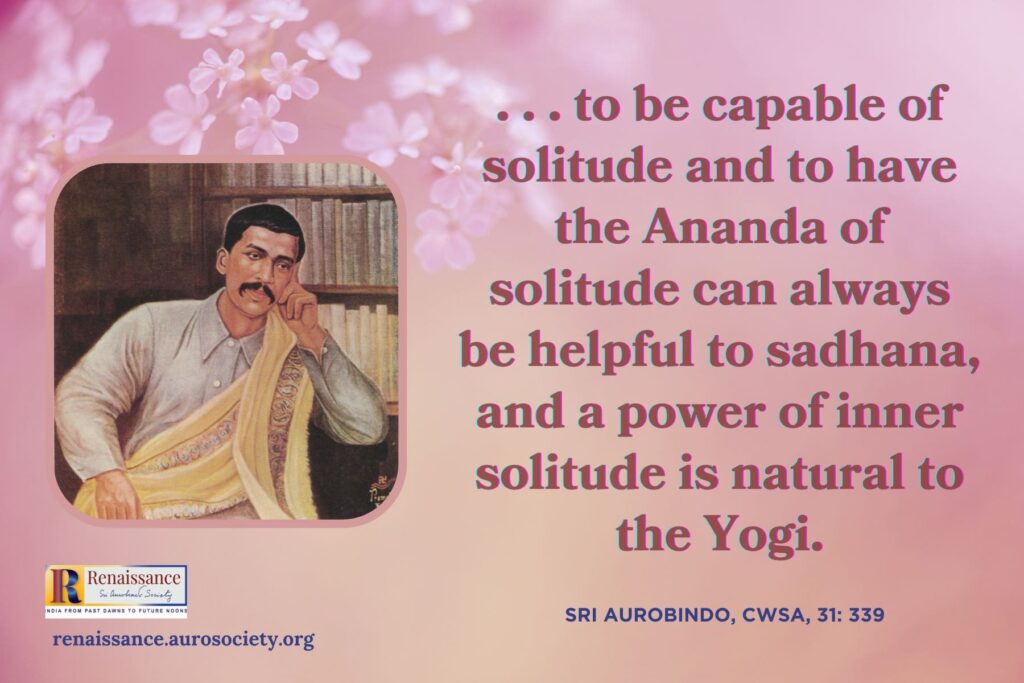Greetings and Happy New Year 2022! For this first issue of the year, we focus on Receptivity – the next attribute in the twelve soul-qualities that the Mother said are necessary for full manifestation of Her Work.
Two things instantly come to mind whenever I think of ‘Receptivity.’ One is Grace and the other is that tiny pink flower I saw one late afternoon fourteen years ago.
I start with the flower. I remember that moment as if it was yesterday, when I noticed that little deep pink flower on the roadside while walking home. On any other day I might have missed it like many others walking by probably did. But certainly some special Grace was blessing me that day with the necessary receptivity so that I would pay attention and learn what I must from that tiny flower.
What caught my attention was the way the tiny flower was gracefully revealing its head from within a thick pile of construction rubble on a street corner. Can anything so delicate grow out of such dark and hard material? Indeed. That flower was the proof!
The resilience with which this flower was blooming in such harsh physical surroundings made me think of the power of opening and receptivity. Within the hard shell of cement, brick and stone debris, perhaps there was some little spot which opened itself to the Light and Force of the Mighty Mother Nature and voila, Life was born! A flower was born.
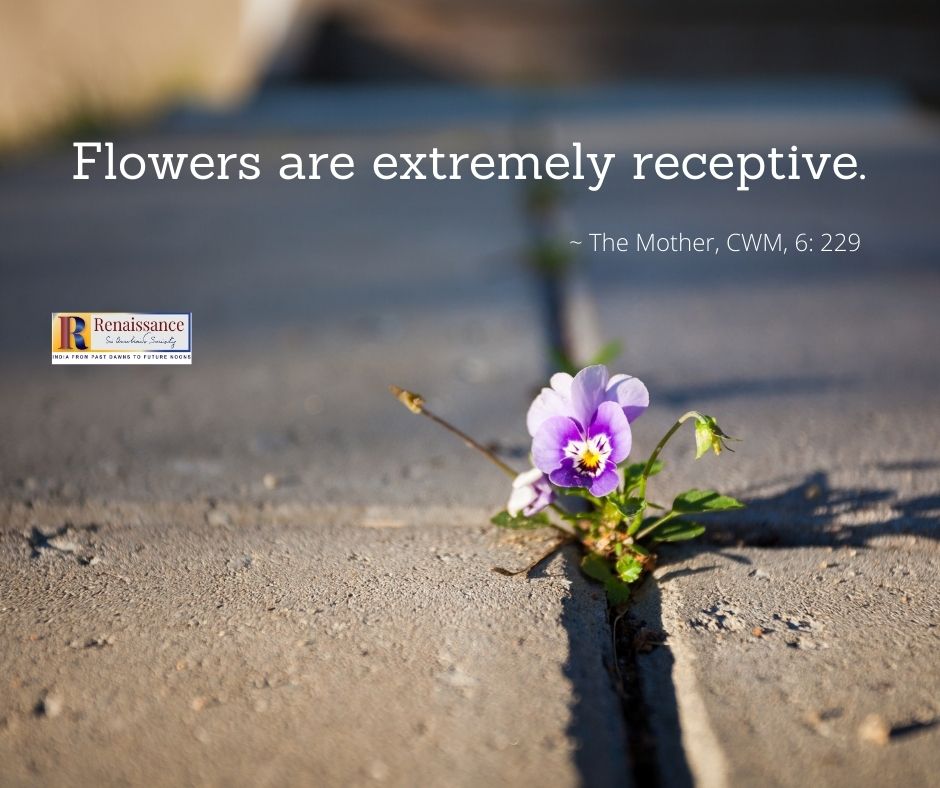
Opening Ourselves to Light and Force
How can we open ourselves more and more to the Light and Force? How do we develop within us a greater receptivity to receive this Light and Force?
The Great Masters everywhere have emphasised several ways; foremost among them are: sincere and patient one-pointed aspiration, genuine humility, unyielding faith and complete trust in the Divine, elimination of ego-insistence in all forms, and self-offering and surrender to the Divine.
Eliminating ego-insistence of course takes immense tapasya, but becoming more conscious of when we resist to something because of our egos can gradually help us become more open. We close ourselves to the Force when we fill ourselves tightly with ego and its countless demands. We carry too much burden and weight of our egos which leaves little open space within for the Light and Force from Above to enter. True and sincere humility implies going to the Divine in all our nakedness, without hiding any of our imperfections and mistakes, without deluding ourselves in any way, and without any sense of pride at any little progress we might have made on the path.
Be humble, be sincere, be receptive – this is the key. Like that little pink flower that was happily and humbly growing in the middle of a construction dump, opening itself to the Light above and receiving the Force to help grow and spread its self-existent beauty and joy, even when no one was looking.
Aspiration, Receptivity and Grace
Receptivity also activates the working of Divine Protection and Grace, even though they are always there. It is only we who step out of Her Protection and Grace.

Indian spiritual tradition proclaims that all existence is a gradual self-expression, a progressive manifestation of the Divine. But without the vision to experience the world — and everything and everyone in the world — as a manifestation of the Divine, and more importantly, without the experience of our own self as a manifestation and as a portion of the Divine we continue to be in Ignorance and separated from the omnipresence of the Divine.
Only with a sincere, one-pointed aspiration and the Divine Grace, the many layers of the veil are slowly removed and a sādhaka is blessed with the deeper, inner vision that sees the Divine within and all around.
SEE:
Sādhanā: An Audio-Visual Meditation on Sincerity
Such intense sādhanā includes rejection of all that obstructs the path of aspiration, and surrender of one’s entire being and all the movements within – the act of aspiration and the rejection included – as an offering to the Divine so that He may decide the course of one’s sādhanā and its outcome.
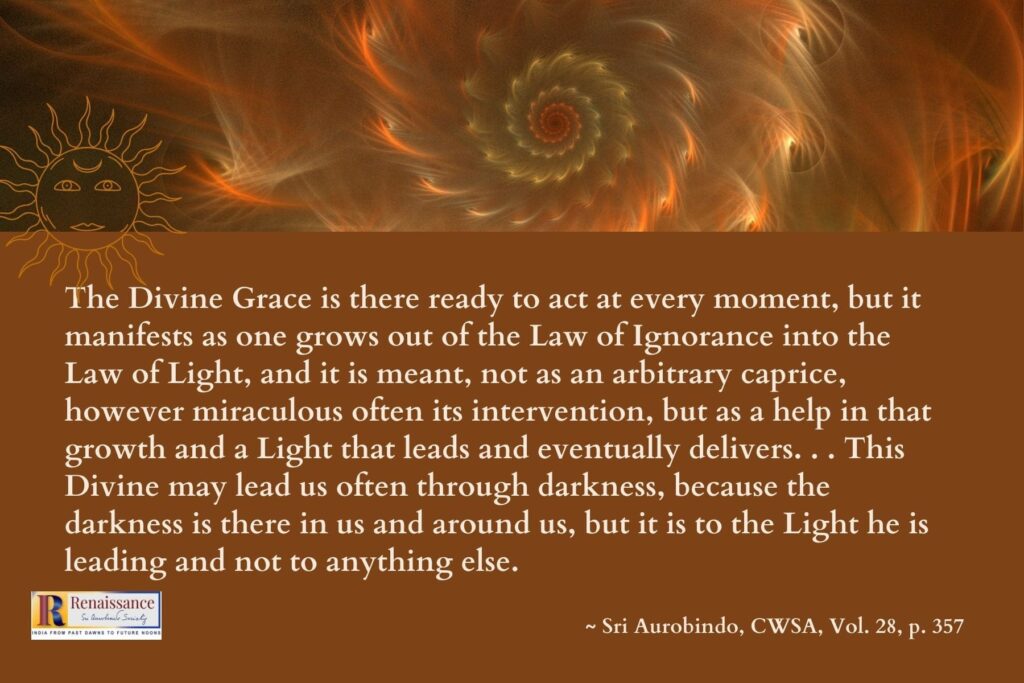
While the Divine Grace is there all the time, its action in an individual’s life is dependent upon how ready one is for its working. This readiness is a matter of several things – one’s aspiration, surrender, faith, sincerity and one’s receptivity.
As long as one is primarily living in Ignorance and as long as one’s lower nature is the primary driving force behind one’s actions – which is generally a very long time – one may never fully or even partially get to sense the working of this Grace. The more the veil of Ignorance is lifted bit by little bit, the more one is able to see how even from behind this veil, the Divine in His Vast, Compassionate Grace has been the protector amidst the dark chambers of the Ignorance and a guide towards brighter and brighter Light.
The mysterious working of this Grace then becomes more and more real for the sādhaka, though as the Mother tells us even then this sense of Grace’s working may be very partial and inexact. Yet, the deepening of the trust that the Grace is behind everything is in itself a big step towards a more complete surrender. It also helps in elimination of the ego-insistence.
And even when periods of darkness come, which they must, the sādhaka begins to see that this too is the working of the Grace because through this darkness he is being prepared for a brighter Light that is just beyond the corner.
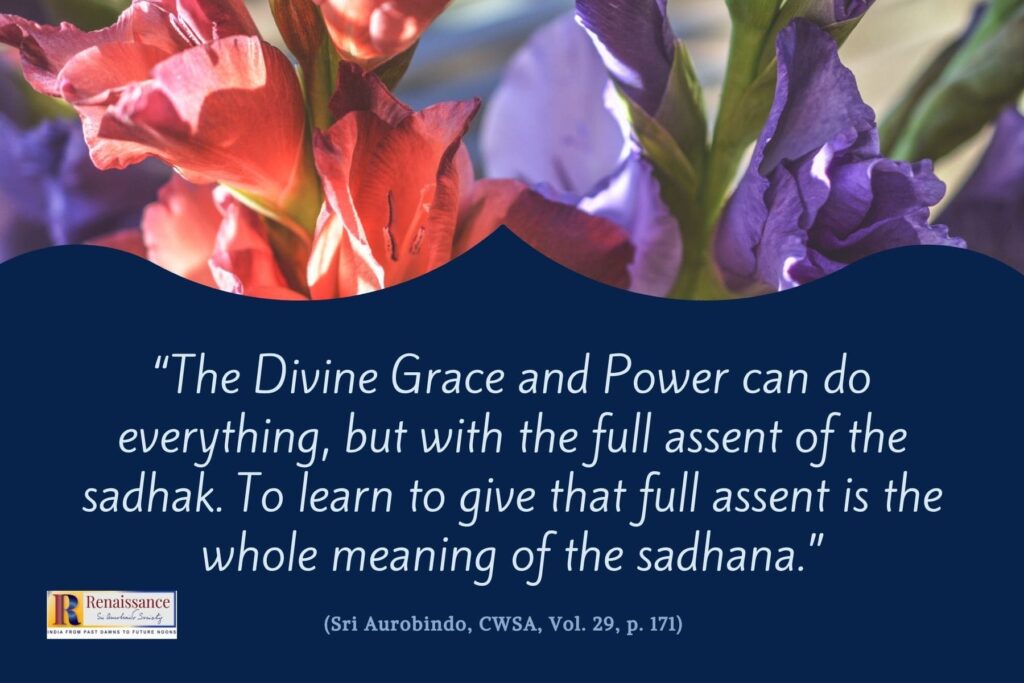
To Give Full Assent
Speaking of the all-powerful and omnipotent quality of Grace, Sri Aurobindo once said that to learn to give full assent to the working of the Divine Grace is sādhanā. There can be no better definition of sādhanā!
As long as my assent is lacking in any small way, I am not fully ready to receive the full power and effectiveness of Grace. The more my assent becomes complete and unreserved, the more completely and effectively the Divine showers His Grace upon me. So my task is to keep practicing this art of full assent, which includes a triple labour of aspiration, rejection and surrender.
ALSO SEE:
Sādhanā: To combine passive receptivity and realising activity
It is said that even the initial turn of the heart and mind to the Divine’s Call is itself a working of the Grace. So while one’s personal effort is essential, even the will and capacity to make this personal effort are the blessings of the Divine Grace. As the sādhanā deepens, as the aspiration gets more intense and purified, as the śraddhā gets more fixed and surrender more complete and sincere, the Divine responds with His Grace and the sādhaka‘s steps begin to become sure and steady on the path.
This special action of the Grace is in response to the sādhaka’s aspiration, faith and receptivity. Yet this Grace was always there working for the sādhaka, except that he or she didn’t have the faculties to “see” it. Once something within awakens to the call of the inner truth, one begins to sense an aspiring flame within, which if tended well grows in intensity. As this aspiration grows, so does one’s opening and receptivity which determine the ability to ‘feel’ the Grace which was always working in numerous hidden and mysterious ways.
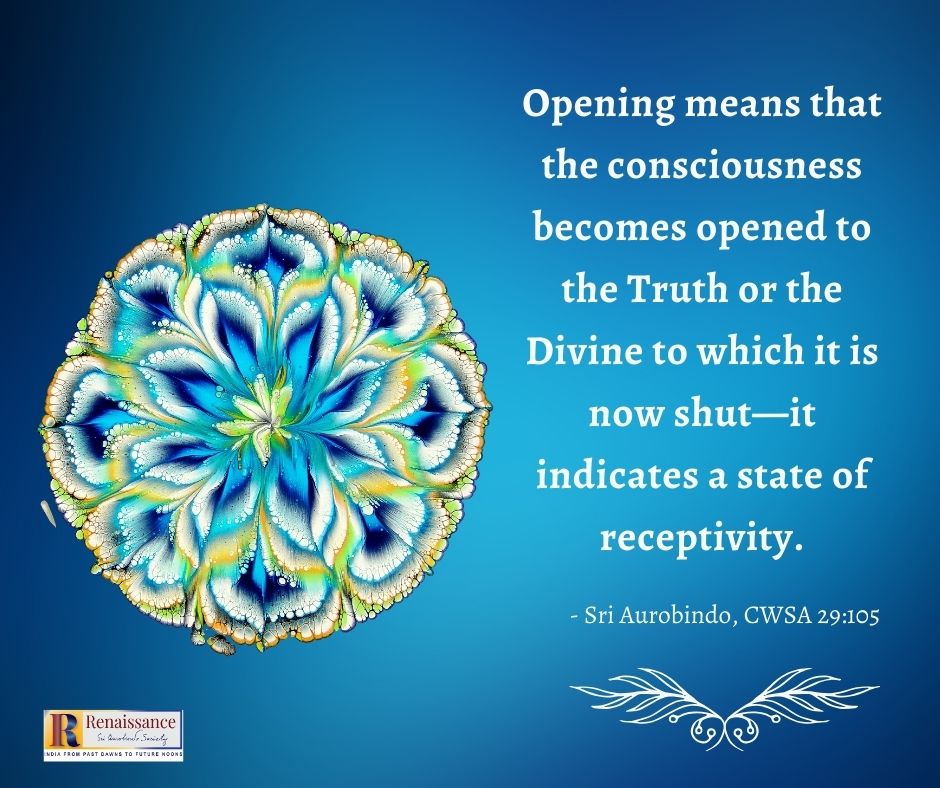
Think of the rains.
Every monsoon season the Grace-full rains pour down from the skies above – everywhere, all around, for everyone. But only those who have developed a system for rainwater harvesting can access this bounty for further specific use. In a larger sense the rain is helpful for all and everything in the creation.
We all enjoy and derive the benefit from this seasonal gift of the Mother Nature, like we do from other seasons. But if we could harvest the rainwater we would purposefully and in a focused, directed way ‘draw’ the bounty of rain (Grace) towards us, in response to our ‘call’ for the rainwater (Grace).
Or think of what it takes to receive and channel the light from the Sun using the right apparatus to use it as a source of energy. In the same way, while the Divine Grace is omnipresent and omnipotent and through our sincere aspiration and steadfast faith we ‘draw’ it towards us in response to our call. But to invoke the Grace is not to pull it or force it. It is actually about making a quiet and sincere call to the all-powerful Divine, and and open oneself to receive it. As Sri Aurobindo reminds us, “aspiration, sincerity and the quietude of the mind are the three best conditions for opening” (CWSA, Vol. 29, p. 105).
The working of the Grace will not always be obvious, in fact many times it will take the sādhaka through a period of darkness yet with a purpose behind it. This mysterious working of the Grace that is not comprehensible by human reason is one sure indication that it is, in fact, the Grace of the Divine, of the One Supreme that is beyond all comprehension.
What we need to do is to stay open, become receptive to His Force.
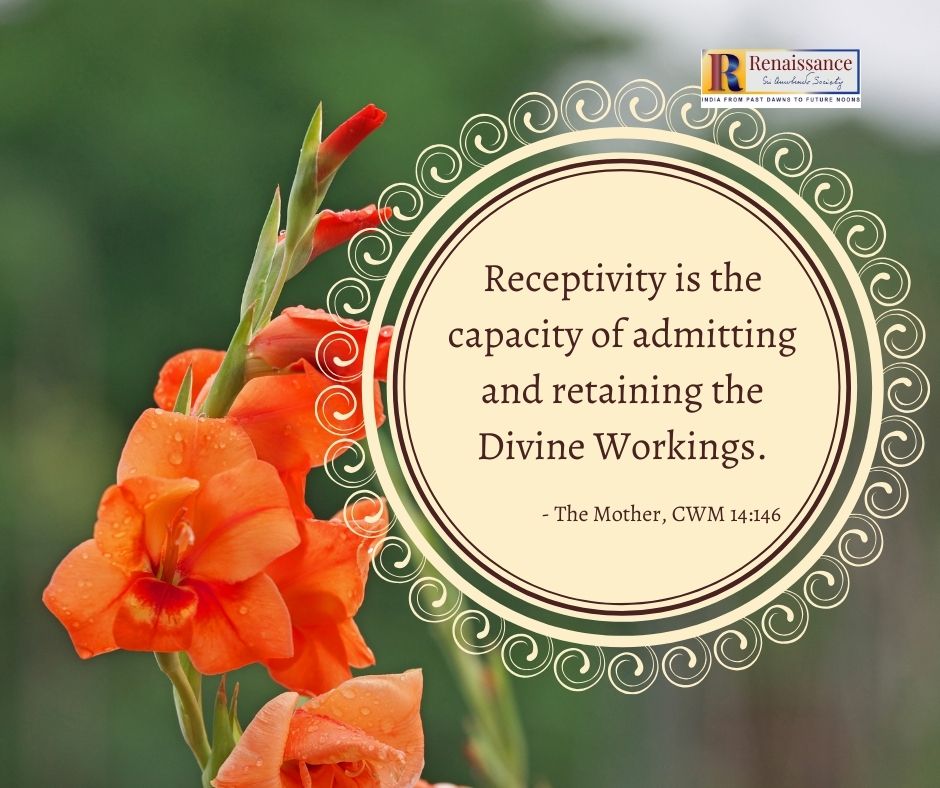
Our Offerings in the Current Issue
As always we begin with Guiding Light section which features a few selections from the works of Sri Aurobindo and the Mother highlighting some key ideas: what does it mean to be open to receive the Force; on what does receptivity depend; how is receptivity connected to aspiration and sincerity; what is the significance of becoming collectively more receptive; and a few more. Sri Aurobindo’s words in the feature titled “Only One Force Acting in the World” help us deepen our understanding of the nature of the Divine Force and the conditions for its working.
The Sunlit Path feature presents a few messages and notes sent by Sri Aurobindo and the Mother to Champaklal ji or to other disciples, compiled by Champaklal ji in his books. These offer some practical guidance on becoming more receptive and open. We get more valuable guidance from Sri Aurobindo in another feature titled Receptivity to the Force for Work.
In the feature titled “It isn’t the forces that are limited, it is the receptivity,” the Mother tells us how one may draw on the universal vital force and increase the receptivity to the higher force. Selections in ‘Sri Aurobindo’s and the Mother’s Force for Healing‘ help us understand the conditions under which the spiritual force works to cure illnesses. We also get a glimpse of how the Mother and Sri Aurobindo were using the Divine Force to help sādhaka-s in their healing.
Another feature highlights the Mother’s conversation about the special working of the Divine Force during the Balcony Darshan and Ashram playground Concentration. Her explanation guides us on the attitude we should cultivate when we go for Darshan or even to the Samadhi.
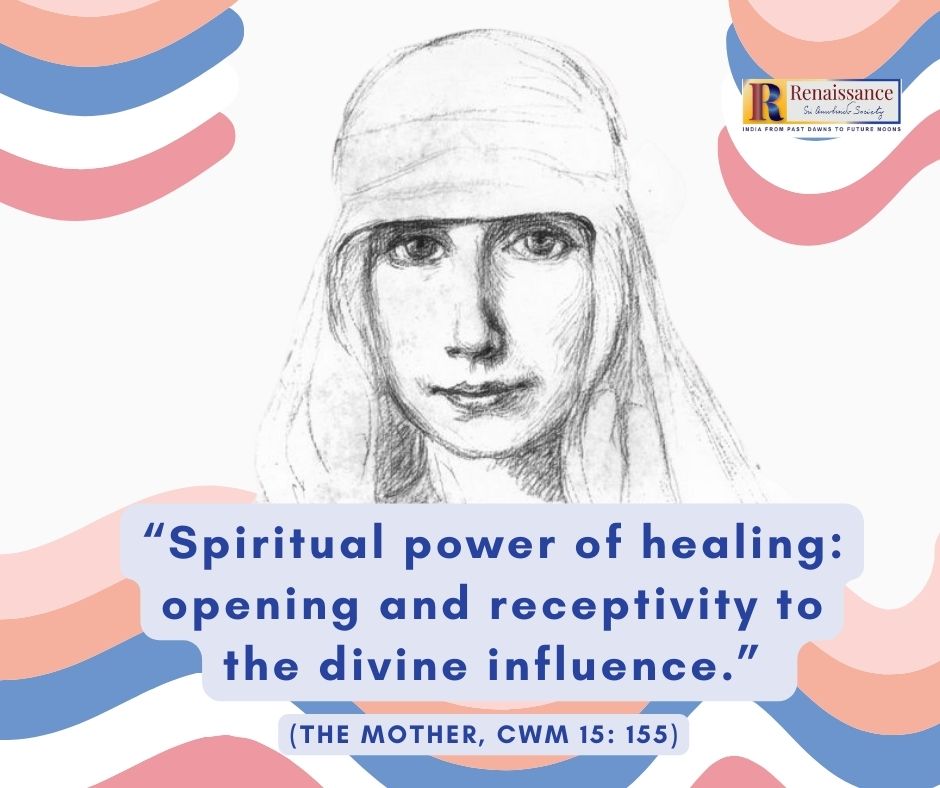
The Force that Made Poets features selected correspondence between a few sādhaka-s and Sri Aurobindo regarding how his Force guided them in their poetic work. Another feature highlights a few words of the Mother about the receptivity of flowers, stones and ornaments.
Silviu Craciunas, an anti-communist activist who was contemplating suicide in a Romanian prison, had visions of an unknown Indian sage whose name he caught as Aurobin Dogos, and found the strength to survive his ordeal. In a special feature titled “Wherever there is a receptivity, the Force acts” – A Prisoner’s Transformation we present a few relevant excerpts from his book where he speaks of this working of Sri Aurobindo’s Force. The Mother’s comment on this incident is also included.
In the Divine Humour section, readers will find selected correspondence of Nirodbaran with Sri Aurobindo about the working of Sri Aurobindo’s Force and its receptivity by the sādhaka-s. In Tales and Stories, we bring two short stories written by Pratyasha Nithin, a young author and artist whose work is inspired by her adoration for her ishta devata, Lord Ganesha.
For our Insightful Conversations series, we bring ‘Antaryatra: An Artist’s Journey Within’ featuring Bindu Popli who for the last 30 years has been immersed in creating art that comes from a place deep within her. The Sword-Lily: Of Gladiators and Receptivity is the title of this month’s flower-meditation by Sheeba Naaz on the flower Gladiolus .
Starting with this issue we serialise a long essay titled Sacrifice and Egoism, published in the 1952 issue of Sri Aurobindo Circle. The first two parts of the essay are published in the current issue and the remaining two will be published in the next one. The next part of our ongoing series – सर्वे सन्तु निरामयाः – May All be Free from Illness – 8 is also included.
Remembering an Unsung Hero of Indian Freedom Movement

January 5 was the birthday of Barindra Kumar Ghose, Sri Aurobindo’s younger brother, and a great revolutionary in the Swadeshi movement in early 20th century. He became a national hero because of the role he played in the Jugantar movement and the Alipore Bomb case. But it is unfortunate that his name somehow remains ignored in the annals of history of Indian freedom movement.
For our book of the month, we feature last chapter of his book The Tale of My Exile: Twelve Years in Andamans. It is important that in this 75th year of Indian independence, more and more Indians come to learn about these unsung heroes.
In addition to Barin Ghose, the month of January also witnessed birthdays of a few other significant personalities who have made gigantic contributions toward India’s cultural and national reawakening. We make special note of Swami Vivekananda (January 12), Nolini Kanta Gupta (January 13), Dilip Kumar Roy (January 22), and Subhash Chandra Bose (January 23). It feels most appropriate to close this editorial by offering our gratitude and pranams to these great sons of Mother India.
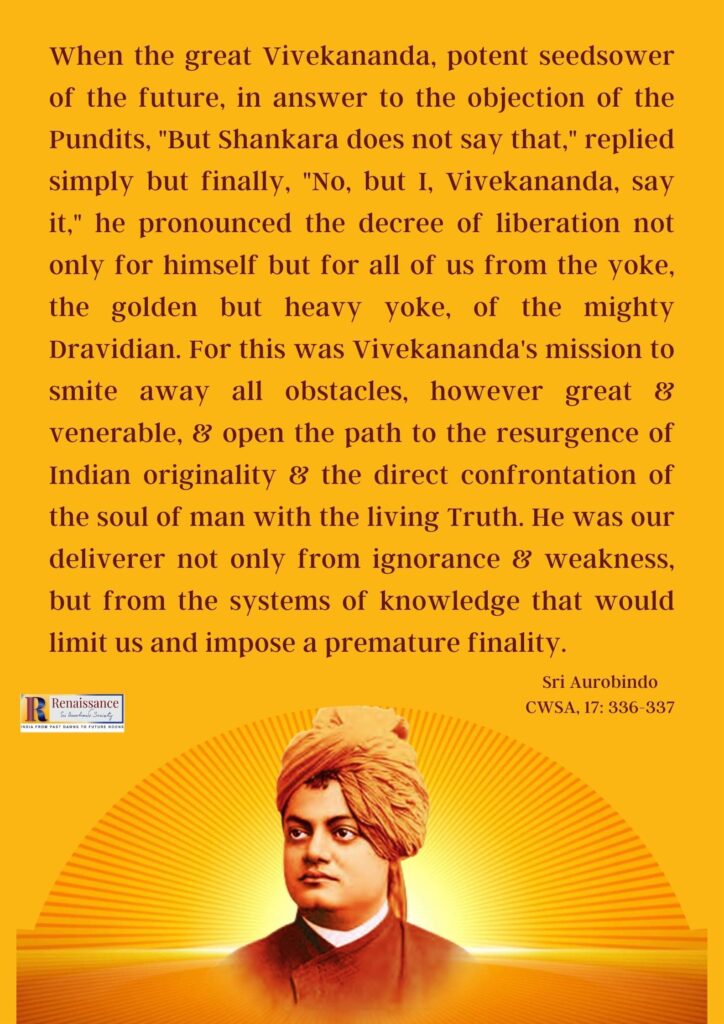

I also take this opportunity to remind our readers to follow us on Facebook where we regularly share updates about the journal contents, study groups and other events, including our tributes to select personalities whose lives and works continue to inspire and light our paths in service of our beloved Mother India.


We hope that our readers will find value and inspiration in this issue’s offerings. As always, this work is offered at the lotus feet of Sri Aurobindo and the Mother.
In gratitude,
Beloo Mehra (for Renaissance Editorial Team)

~ Design: Beloo Mehra & Biswajita Mohapatra

